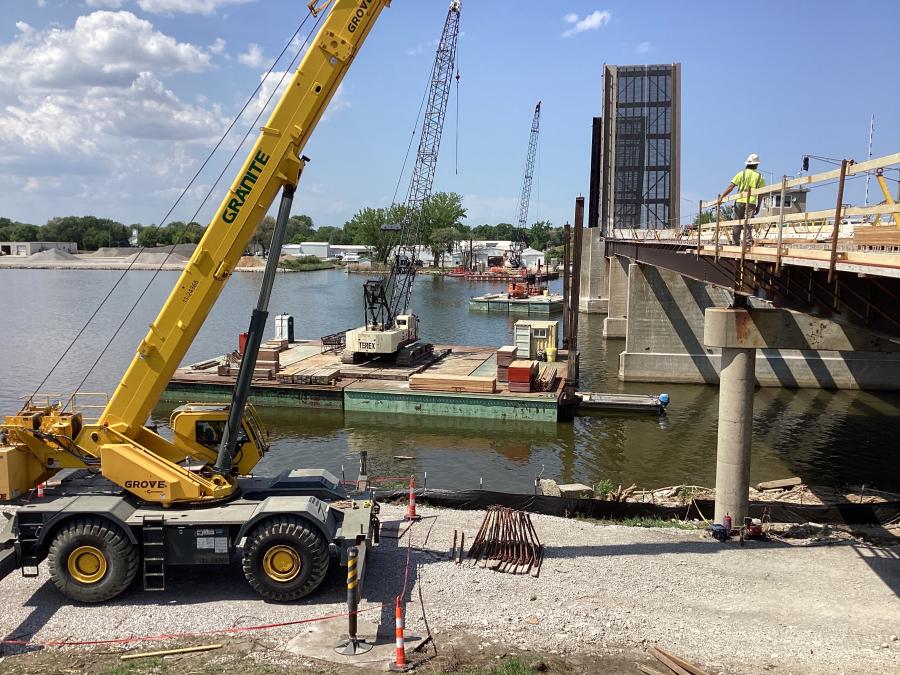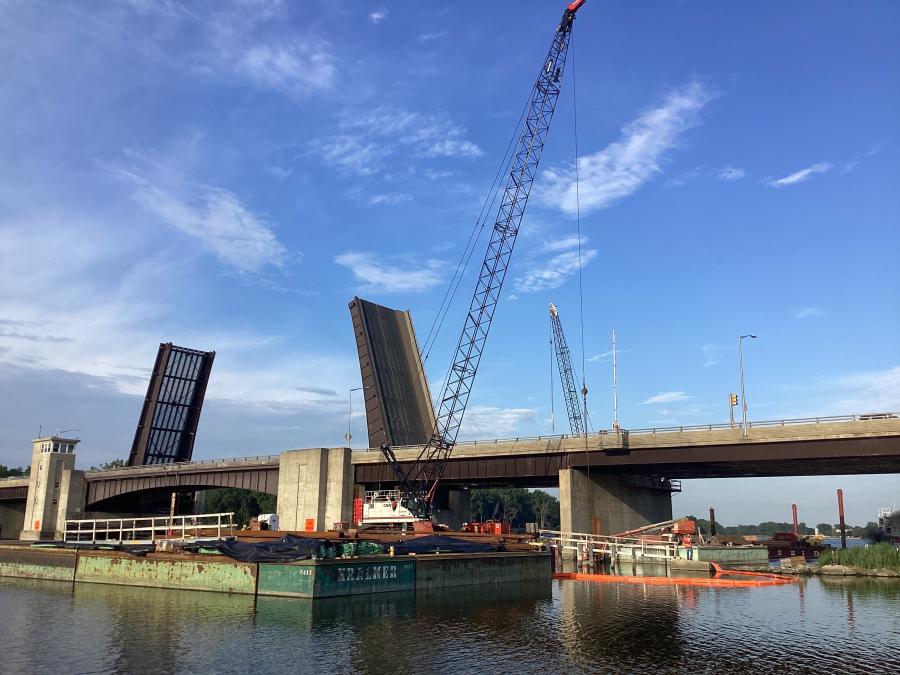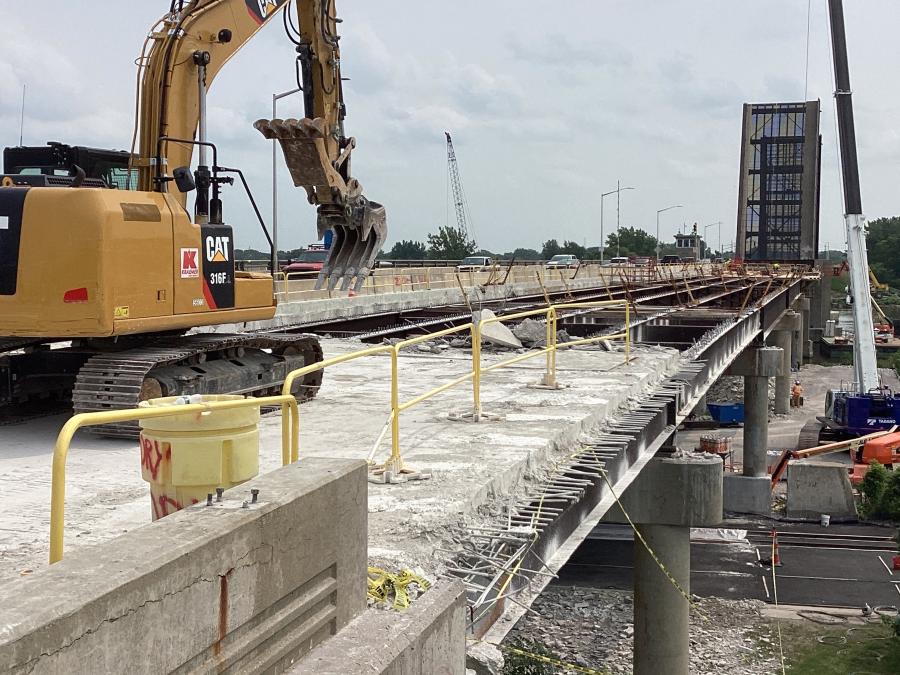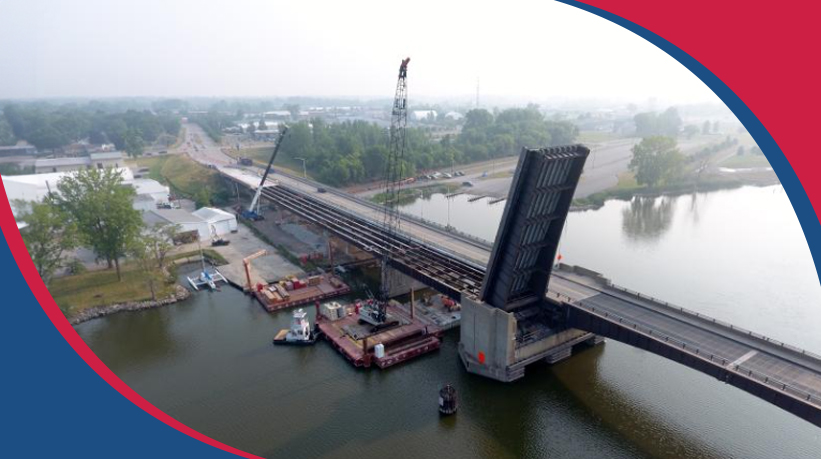Originally Published on OCT 25, 2023
Source: https://www.constructionequipmentguide.com
In Bay City, Mich., construction crews are performing a much-needed rehabilitation and modernization of Independence Bridge. Construction on the multi-million dollar project began in early 2023, with all four lanes targeted to reopen to traffic by the end of next year.
“The city of Bay City, Michigan, owns two bascule bridges over the Saginaw River that have experienced multiple unplanned closures and needed significant repair,” said Kevin Bischel, project delivery director, United Bridge Partners (UBP). “Movable bridges are many times more expensive to build and maintain compared to fixed bridges, and the city did not have the financial resources to address the capital improvements needed to keep the bridges open, safe and reliable.”

Bay City Bridge Partners (BCBP), the local subsidiary of UBP, was selected to rehabilitate both the Liberty and Independence bridges. The city and BCBP entered into a long-term lease-concession agreement where BCBP committed to finance, design, construct, operate and maintain the bridges at no cost to the city.
“The project team conducted detailed hands-on structural, mechanical and underwater investigations to develop the proposed scope of improvements,” said Bischel. “The evaluation of the bridge’s condition found the deck and control systems needed to be fully replaced, but the foundation, piers and beams were generally in satisfactory condition.”
As a result, engineering teams for BCBP and the city recommended complete rehabilitation and modernization of Independence Bridge.
“Compared with a new bridge, the rehabilitation option was found to have reduced environmental impacts, as the Saginaw River is habitat to several endangered species. The rehabilitation option also eliminated drilling for the new piers and demolition of the old piers that could release contaminated sediments into the river. Utilizing the existing bridge also avoided potential traffic issues with ‘S curves’ that could be caused by constructing a new bridge adjacent to the existing bridge.”
UBP designs, finances, owns, operates and maintains private toll bridges and assumes all financial and delivery risks and allows projects that might not otherwise be completed to move forward.
“UBP has worked with TranSystems and Granite-Kraemer JV on several bridges, including the recently completed Liberty Bridge,” said Bischel. “UBP has utilized the Construction Manager/General Contractor [CM/GC] method for project delivery on this and several other projects. The contractor team is engaged from day one and provides essential feedback on the design. This arrangement allows UBP to make timely design decisions with accurate cost and constructability input.”
The current rehab includes complete replacement of the concrete deck, inclusive of the bridge joints, traffic railing and drainage scuppers, as well as replacement of the bridge electrical system with modern components to provide better, more reliable operation. Crews also will rehabilitate bridge machinery, including rehab of the span drive machinery and replacing the brakes and motors.
Other tasks include performing structural steel repairs to approach spans, including replacing or repairing cracked diaphragm connection plates, and replacing the bearings at the north approach spans and at the south and north abutments. In addition, the concrete diaphragm at the north abutment and the adjacent concrete pavement unit will require reconstruction.
Work also includes an open road all-electronic tolling system with closed system video and cameras, architectural improvements and upgrades to the bridge operator’s house and the addition of color changing lighting on the bascule piers.
“This is our second bascule bridge in Bay City and construction is going well,” said Bischel. “We have partnered with the same engineering and contractor teams as the Liberty project, and these teams have been able to apply efficiencies developed at Liberty Bridge to the Independence Bridge.”
Some mechanical and electrical work, as well as commissioning of bascule systems, will continue into early 2025 when the bridge doesn’t need to be raised for ships. The United States Coast Guard does not require the bridge to open from Jan. 1 to March 31 of each year, due to ice on the river.
Bischel noted the sequencing and phasing of work has been developed to minimize the construction impacts to Bay City residents, adjacent businesses and the traveling public.

“Two of the bridge’s four lanes will remain open to traffic throughout the project, except for short-term closures for concrete pours and bascule commissioning. This was accomplished by decoupling the north and southbound bascule leaves both mechanically and electrically, so that bascule leaves could be operated independently.”
Since the mechanical components of the bridge are required to be removed and shipped off-site to be rehabilitated, much of the work must be completed while the movable span is not functional.
“Additionally, the only time we’re permitted to keep the bridge in the down position, and therefore blocking river traffic, is in the winter. This leaves a large amount of work, and many critical activities that must be performed in the cold winter months, including re-installing the machinery to make the movable span functional before the river opens back up to ship traffic.” Bischel noted that working on a bascule bridge rehab requires a great deal of expertise.
“Movable bridge work is highly specialized and requires a greater understanding of complex movable systems, compared to a standard fixed-span structure. The electrical, mechanical and structural systems must be well coordinated, so there’s harmony between the moving parts.
“Our lead engineering firm is TranSystems, with support by WJE for mechanical and electrical design support. Experience and qualified engineering consultants and contractors are critical for successful completion of this type of project.”
Currently, the west side bridge sidewalk, median and handrail are being installed by crews. The west side machinery has been removed and is currently being rehabilitated by a subcontractor in Alabama.
Already, the west half of the concrete bridge deck and bearings have been removed and replaced. The causeway has been installed, substructure patching repairs are mostly complete, and the submarine cable has been directionally bored.
According to Ryan Clark, vice president of Granite Construction, crews recently finished pouring concrete on the first section of new decking.
“The last concrete deck pour was 600 feet long by 36 feet wide, a 640-cubic-yard pour and took about nine hours for our 25-person crew to complete.”
Construction has included nighttime pours, when temperatures are lower. In fact, night pours for cast-in-place concrete bridge decks are a Michigan Department of Transportation specification requirement.
West side mechanical installations and commissioning will be completed this winter, then crews will switch traffic to put cars on the west side. Once that takes place, workers will remove the east machinery and ship offsite for refurbishing and reinstallation in the winter of 2024.
“We also will replace the east bridge decks, update the operator house, install a backup generator, lighting, roadway finishes and tolling infrastructure,” said Clark.
Independence Bridge consists of 11 spans of varying length, carrying four lanes of traffic and two sidewalks over the Saginaw River and Huron and Eastern Railroad. The overall bridge length is 1,210 ft. 9 in. long and 73 ft. 5 in. wide, with a 208 ft. 6 in. rolling-lift double leaf bascule main span. The bascule span is split down the middle, making for four independent leaves.
As for the weather’s effect on the project, said Clark, “The winter temperatures are not conducive to pouring structural concrete; therefore, we aim to complete all structural concrete outside of the winter months. On the other hand, since ship traffic on the river stops during the winter, the United States Coast Guard allows us to keep the bascule span in the down position, which is critical for machinery work, since the bridge is not functional during this work.”
The most time-consuming part of the rehab will be the off-site mechanical rehabilitation, as it takes approximately nine months to finish. During this time, the bridge is unable to open or close under its own power.

To complete the project, a variety of heavy equipment is needed, including an 80-ton rough-terrain crane; an 80-ton hydro-crawler; a 110-ton lattice boom crawler crane; numerous excavators; a Cat 950 wheel loader; a skid steer; two tugboats; a 360 hp twin screw; a 600 hp twin screw; six sectional barge spreads; and manlifts.
Main materials include structural concrete, rebar, handrail, bearings, along with refurbishing of span-drive machinery, center locks and heel locks. Terry Velligan, general manager of BCBP, noted that BCBP is committed to optimizing the use of a local workforce, union labor, local material and equipment suppliers, local engineering and technical consultants and professional services.
“BCBP is a very active participant within the community, which starts with our management / operations team located in Bay City. We are thrilled the city of Bay City has trusted BCBP to deliver this project. The four river bridges in Bay City are critical transportation links that are essential to area businesses and residents. It’s rewarding to the project team that our innovative solution and successful project delivery will allow two of these structures to remain open and reliable for years to come.” CEG

